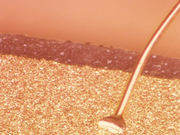Findings among patients receiving treatment for face, scalp actinic keratoses
WEDNESDAY, Feb. 17, 2016 (HealthDay News) — Pulse photodynamic therapy (pulse-PDT) and corticosteroid pulse-PDT reduce treatment-induced erythema in patients treated for actinic keratoses (AK), according to a study published online Feb. 8 in the British Journal of Dermatology.
Stine Regin Wiegell, M.D., from the University of Copenhagen in Denmark, and colleagues evaluated pulse-PDT and corticosteroid pulse-PDT in 22 mild AK patients. Participants were treated on the face and scalp with methyl aminolevulinate (MAL)-PDT using incubation with MAL for 30 minutes (pulse-PDT; two areas) and three-hour MAL incubation (c-PDT; one area). Before and just after pulse-PDT, a super potent corticosteroid was applied (S-pulse-PDT). After three hours, all areas were illuminated with red light.
The researchers found that pulse-PDT significantly reduced PDT-induced erythema (P = 0.020), and erythema was even further reduced by S-pulse-PDT (P < 0.0001). After three months, the complete lesion response did not differ significantly between the three treated areas.
“The use of short MAL application time and topical corticosteroid did not affect the efficacy of PDT and may be an easy way to make PDT treatment of large visible areas more acceptable,” the authors write.
Two authors disclosed financial ties to Galderma.
Copyright © 2016 HealthDay. All rights reserved.








